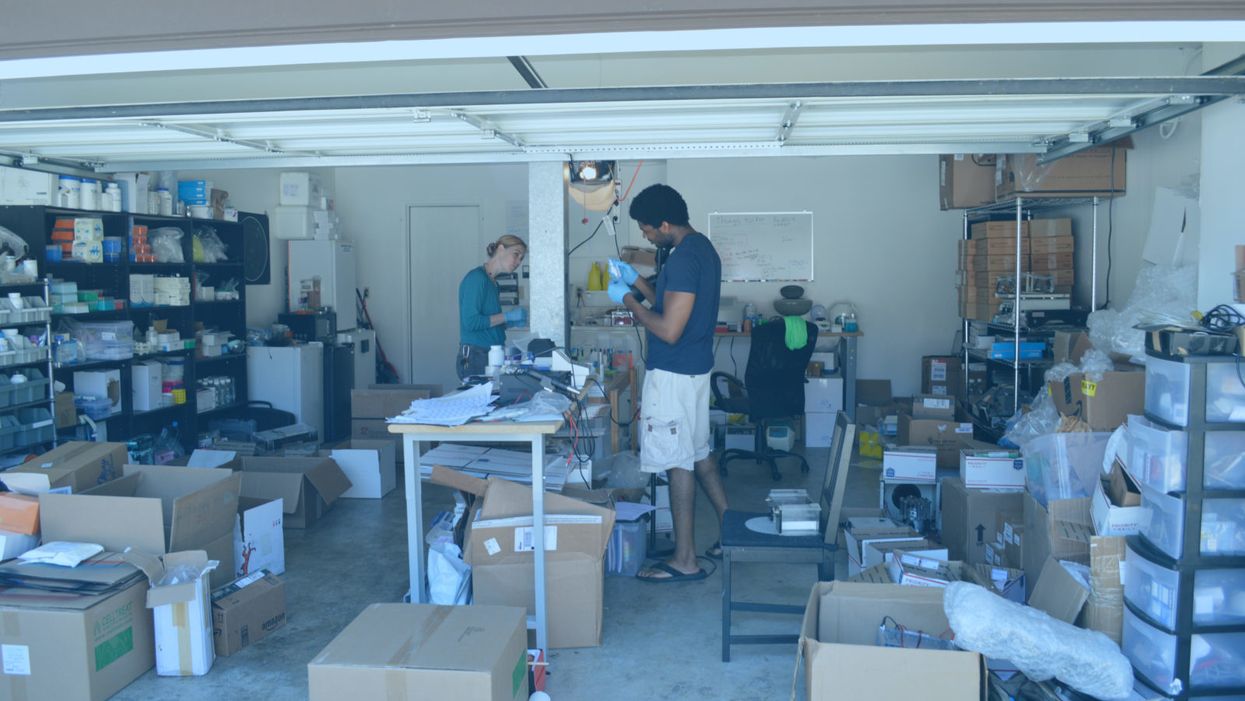Hacking Your Own Genes: A Recipe for Disaster

Employees of ODIN, a consumer genetic design and engineering company, working out of their Bay Area garage start-up lab in 2016.
Editor's Note: Our Big Moral Question this month is: "Where should we draw a line, if any, between the use of gene editing for the prevention and treatment of disease, and for cosmetic enhancement?" It is illegal in the U.S. to develop human trials for the latter, even though some people think it should be acceptable. The most outspoken supporter recently resorted to self-experimentation using CRISPR in his own makeshift lab. But critics argue that "biohackers" like him are recklessly courting harm. LeapsMag invited a leading intellectual from the Center for Genetics and Society to share her perspective.
"I want to democratize science," says biohacker extraordinaire Josiah Zayner.
This is certainly a worthy-sounding sentiment. And it is central to the ethos of biohacking, a term that's developed a bit of sprawl. Biohacking can mean non-profit community biology labs that promote "citizen science," or clever but not necessarily safe or innocuous garage-based experiments with computers and genetics, or efforts at biological self-optimization via techniques including cybernetic implants, drug supplements, and intermittent fasting.
They appear to have given little thought to whether curiosity should be bound in any way by care for social consequence.
Against that messy background, what should we make of Zayner? The thirty-something ex-NASA scientist, who describes himself as "a global leader in the BioHacker movement," put his interpretation of democracy on display last October during a CRISPR-yourself performance at a San Francisco biotech conference. In that episode, he dramatically jabbed himself with a long needle, injecting his left forearm with a home-made gene-editing concoction that he said would disrupt his myostatin genes and bulk up his muscles.
Zayner sees himself, and is seen by some fellow biohackers, as a rebel hero: an intrepid scientific adventurer willing to risk his own well-being in the tradition of self-experimentation, eager to push the boundaries of established science in the service of forging innovative modes of discovery, ready to stand up to those stodgy bureaucrats at the FDA in the name of biohacker freedom.
To others, including some in the biohacker community, he's a publicity-seeking stunt man, perhaps deluded by touches of toxic masculinity and techno-entrepreneurial ideology, peddling snake-oil with oozing ramifications.
Zayner is hardly coy about his goals being larger than Popeye-like muscles. "I want to live in a world where people are genetically modifying themselves," he told FastCompany. "I think this is, like, literally, a new era of human beings," he mused to CBS in November. "It's gonna create a whole new species of humans."
Nor does he deign to conceal his tactics. The webpage of the company he launched to sell DIY gene-editing kits (which is advised by celebrity geneticist George Church) says that Zayner is "constantly pushing the boundaries of Science outside traditional environments." He is more explicit when performing: "Yes I am a criminal. And my crime is that of curiosity," he said last August to a biohacker audience in Oakland, which according to Gizmodo erupted in applause.
Regrettably, Zayner, along with some other biohackers and their defenders in the mainstream scientific world, appear to have given little thought to whether curiosity should be bound in any way by care for social consequence.
In December, the FDA issued a brief statement warning against using DIY kits for self-administered gene editing.
Though what's most directly at risk in Zayner's self-enhancement hack is his own safety, his bad-boy celebrity status is likely to encourage emulation. A few weeks after his San Francisco performance, 27-year-old Tristan Roberts took to Facebook Live to give himself a DIY gene modification injection to keep his HIV infection in check, because he doesn't like taking the regular medications that prevent AIDS. Whatever it was that he put into his body was provided by a company that Gizmodo describes as a "mysterious biotech firm with transhumanist leanings."
Zayner doesn't outright provide DIY gene hacks to others. But among his company's offerings are a free DIY Human CRISPR Guide and a $20 CRISPR-Cas9 plasmid that targets the human myostatin gene – the one that Zayner said he was targeting to make his muscles grow. Presumably to fend off legal problems, the product page says: "This product is not injectable or meant for direct human use" – a label as toothless as the fine print on cigarette packages that breaks the news that smoking causes cancer.
Some scientists warn that Zayner's style of biohacking carries considerable dangers. Microbiologist Brian Hanley, himself a self-experimenter who now opposes "biohacking humans," focuses on the technical difficulty of purifying what's being injected. "Screwing up can kill you from endotoxin," he says. "If you get in trouble, call me. I will do my best to instruct the physician how to save your life….But I make no guarantees you will survive."
Hanley also commented on the likely effectiveness of Zayner's effort: "Either Josiah Zayner is ignorant or he is deliberately misleading people. What he suggests cannot work as advertised."
Ensuring the safety and effectiveness of medical drugs and devices is the mandate of the US Food and Drug Administration. In December, the agency issued a brief statement warning against using DIY kits for self-administered gene editing, and saying flat out that selling them is against the law.
The stem cell field provides an unfortunate model of what can go wrong.
Zayner is dismissive of the safety risks. He asks in a Buzzfeed article whether DIY CRISPR should be considered more harmful than smoking or chemotherapy, "legal and socially acceptable activities that damage your genes." This is a strange line of argument, given the decades-long battles with the tobacco industry to raise awareness about smoking's significant harms, and since the side effects of chemotherapy are typically not undertaken by choice.
But the implications of what Zayner, Roberts, and some of their fellow biohackers are promoting ripple well beyond direct harms to individuals. Their rhetoric and vision affect the larger project of biomedicine, and the fraught relationships among drug researchers, pharmaceutical companies, clinical trial subjects, patients, and the public. Writing in Scientific American, Eleanor Pauwels of the Wilson Center, who is sympathetic to biohacking, lists the down sides: "blurred boundaries between treatments and self-experimentation, peer pressure to participate in trials, exploitation of vulnerable individuals, lack of oversight concerning quality control and risk of harm, and more."
These prospects are germane to the current state of human gene editing. After decades of dashed hopes, including deaths of research subjects, "gene therapy" may now be close to deserving the promise in its name. But with safety and efficacy still being evaluated, it's especially crucial to be honest about limitations as well as possibilities.
The stem cell field provides an unfortunate model of what can go wrong. Fifteen years ago, scientists, patient advocates, and even politicians routinely indulged in wildly over-optimistic enthusiasm about the imminence of stem cell therapies. That binge of irresponsible promotion helped create the current situation of widespread stem cell fraud: hundreds of clinics in the US alone selling unproven treatments to unsuspecting and sometimes desperate patients. Many have had their wallets lightened; some have gone blind or developed strange tumors that doctors have never before seen. The FDA is scrambling to address this still-worsening situation.
Zayner-style biohacking and promotion may also impact the ongoing controversy about whether new gene editing tools should be used in human reproduction to pre-determine the traits of future children and generations. Much of the widespread opposition to "human germline modification" is grounded in concern that it would lead to a society in which real or purported genetic advantages, marketed by fertility clinics to affluent parents, would exacerbate our already shameful levels of inequality and discrimination.
With powerful new technologies increasingly shaping the world, there's a lot riding on our capacity to democratize science. But as a society we don't yet have much practice at it.
Yet Zayner is all for it. In an interview in The Guardian, he comments, "DNA defines what a species is, and I imagine it wouldn't be too long into the future when the human species almost becomes a new species because of these modifications." He notes in a blog post, "We want to grow as a species and maybe change as a species. Whether that is curing disease or immortality or mutant powers is up to you."
This brings us back to Zayner's claim that he is working to democratize science.
The conviction that gene editing involves social and political challenges, not just technical matters, has been voiced at all points on the spectrum of perspective and uncertainty. But Zayner says there's been enough talk. "I want people to stop arguing about whether it's okay to use CRISPR or not use CRISPR….It's too late: I already made the choice for you. Argument over. Let's get on with it now. Let's use this to help people. Or to give people purple skin." (Emphasis added, in case there's any doubt about Zayner's commitment to democracy.)
With powerful new technologies increasingly shaping the world, there's a lot riding on our capacity to democratize science. But as a society we don't yet have much practice at it. In fact, we're not very sure what it would look like. It would clearly mean, as Arizona State University political scientist David Guston puts it, "considering the societal outcomes of research at least as attentively as the scientific and technological outputs." It would need broad participation and demand hard work.
The involvement of serious citizen scientists in such efforts, biohackers included, could be a very good thing. But Zayner's contributions to date have not been helpful.
[Ed. Note: Check out Zayner's perspective: "Genetic Engineering for All: The Last Great Frontier of Human Freedom." Then follow LeapsMag on social media to share your opinion.]
Saliva May Help Diagnose PTSD in Veterans
A recent study finds that former soldiers with post traumatic stress disorders have a certain set of bacteria in their saliva, a distinct signature that is believed to be the first biological marker for PTSD.
As a bioinformatician and young veteran, Guy Shapira welcomed the opportunity to help with conducting a study to determine if saliva can reveal if war veterans have post-traumatic stress disorder, or PTSD.
The research team, which drew mostly from Tel Aviv University’s Sackler Faculty of Medicine and Sagol School of Neuroscience, collected saliva samples from approximately 200 veterans who suffered psychological trauma stemming from the years they spent fighting in the First Lebanon War in 1982. The researchers also characterized the participants’ psychological, social and medical conditions, including a detailed analysis of their microbiomes.
They found that the former soldiers with PTSD have a certain set of bacteria in their saliva, a distinct microbiotic signature that is believed to be the first biological marker for PTSD. The finding suggests that, in the future, saliva tests could be used to help identify this disorder. As of now, PTSD is often challenging to diagnose.
Shapira, a Ph.D. student at Tel Aviv University, was responsible for examining genetic and health-related data of the veterans who participated – information that had been compiled steadily over four decades. The veterans provided this data voluntarily, Shapira says, at least partly because the study carries important implications for their own psychological health.
The research was led by Illana Gozes, professor emerita of clinical biochemistry. “We looked at the bacteria in their blood and their saliva,” Gozes explains. To discover the microbial signatures, they analyzed the biometric data for each soldier individually and as a group. Comparing the results of the participants’ microbial distribution to the results of their psychological examinations and their responses to personal welfare questionnaires, the researchers learned that veterans with PTSD – and, more generally, those with significant mental health issues – have the same bacterial content in their saliva.
“Having empirical metrics to assess whether or not someone has PTSD can help veterans who make their case to the Army to get reparations,” Shapira says.
More research is required to support this finding, published in July in Nature’s prestigious Molecular Psychiatry, but it could have important implications for identifying people with PTSD. Currently, it can be diagnosed only through psychological and behavioral symptoms such as flashbacks, nightmares, sleep disorders, increased irritability and physical aggressiveness. Veterans sometimes don’t report these symptoms to health providers or realize they’re related to the trauma they experienced during combat.
The researchers also identified a correlation that indicates people with a higher level of education show a lower occurrence of the microbiotic signature linked to PTSD, while people who experienced greater exposure to air pollution show a higher occurrence of this signature. That confirms their finding that the veterans’ health is dependent on their individual biology combined with the conditions of their environment.
“Thanks to this study, it may be possible in the future to use objective molecular and biological characteristics to distinguish PTSD sufferers, taking into account environmental influences,” Gozes said in an article in Israel21c. “We hope that this new discovery and the microbial signatures described in this study might promote easier diagnosis of post-traumatic stress in soldiers so they can receive appropriate treatment.”
Gozes added that roughly a third of the subjects in their study hadn’t been diagnosed with PTSD previously. That meant they had never received any support from Israel’s Ministry of Defense or other officials for treatment and reparations, the payments to compensate for injuries sustained during war.
Shapira’s motivation to participate in this study is personal as well as professional: in addition to being veteran himself, his father served in the First Lebanon War. “Fortunately, he did not develop any PTSD, despite being shot in the foot...some of his friends died, so it wasn’t easy on him,” says Shapira.
“Having empirical metrics to assess whether or not someone has PTSD can help veterans who make their case to the Army to get reparations,” Shapira says. “It is a very difficult and demanding process, so the more empirical metrics we have to assess PTSD, the less people will have to suffer in these committees and unending examinations that are mostly pitched against the veterans because the state is trying to avoid spending too much money.”
The Friday Five Weekly Roundup in Health Research
In this week's Friday Five, the right facial expression for your mental health. Plus, can virtual reality reduce pain? Lab made blood vessels. Gene editing muscles to lower blood sugar. And a magic ingredient coming from exhaust vents.
The Friday Five covers five stories in research that you may have missed this week. There are plenty of controversies and troubling ethical issues in science – and we get into many of them in our online magazine – but this news roundup focuses on scientific creativity and progress to give you a therapeutic dose of inspiration headed into the weekend.
Listen on Apple | Listen on Spotify | Listen on Stitcher | Listen on Amazon | Listen on Google
Here are the promising studies covered in this week's Friday Five:
- The right facial expression for your mental health
- Can virtual reality reduce pain?
- Lab made blood vessels
- Gene editing muscles to lower blood sugar
- A magic ingredient coming from exhaust vents

